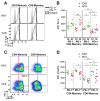Programmed death-1 is a marker for abnormal distribution of naive/memory T cell subsets in HIV-1 infection
- PMID: 23918986
- PMCID: PMC3815464
- DOI: 10.4049/jimmunol.1200646
Programmed death-1 is a marker for abnormal distribution of naive/memory T cell subsets in HIV-1 infection
Abstract
Chronic activation of T cells is a hallmark of HIV-1 infection and plays an important role in disease progression. We previously showed that the engagement of the inhibitory receptor programmed death (PD)-1 on HIV-1-specific CD4(+) and CD8(+) T cells leads to their functional exhaustion in vitro. However, little is known about the impact of PD-1 expression on the turnover and maturation status of T cells during the course of the disease. In this study, we show that PD-1 is upregulated on all T cell subsets, including naive, central memory, and transitional memory T cells in HIV-1-infected subjects. PD-1 is expressed at similar levels on most CD4(+) T cells during the acute and the chronic phase of disease and identifies cells that have recently entered the cell cycle. In contrast, PD-1 expression is dramatically increased in CD8(+) T cells during the transition from acute to chronic infection, and this is associated with reduced levels of cell proliferation. The failure to downregulate expression of PD-1 in most T cells during chronic HIV-1 infection is associated with persistent alterations in the distribution of T cell subsets and is associated with impaired responses to IL-7. Our findings identify PD-1 as a marker for aberrant distribution of T cell subsets in HIV-1 infection.
Figures






References
-
- Brenchley JM, Price DA, Schacker TW, Asher TE, Silvestri G, Rao S, Kazzaz Z, Bornstein E, Lambotte O, Altmann D, Blazar BR, Rodriguez B, Teixeira-Johnson L, Landay A, Martin JN, Hecht FM, Picker LJ, Lederman MM, Deeks SG, Douek DC. Microbial translocation is a cause of systemic immune activation in chronic HIV infection. Nat Med. 2006;12:1365–1371. - PubMed
-
- Giorgi JV, Liu Z, Hultin LE, Cumberland WG, Hennessey K, Detels R. Elevated levels of CD38+ CD8+ T cells in HIV infection add to the prognostic value of low CD4+ T cell levels: results of 6 years of follow-up. The Los Angeles Center, Multicenter AIDS Cohort Study. J Acquir Immune Defic Syndr. 1993;6:904–912. - PubMed
-
- Liu Z, Cumberland WG, Hultin LE, Prince HE, Detels R, Giorgi JV. Elevated CD38 antigen expression on CD8+ T cells is a stronger marker for the risk of chronic HIV disease progression to AIDS and death in the Multicenter AIDS Cohort Study than CD4+ cell count, soluble immune activation markers, or combinations of HLA-DR and CD38 expression. J Acquir Immune Defic Syndr Hum Retrovirol. 1997;16:83–92. - PubMed
-
- Cohen Stuart JW, Hazebergh MD, Hamann D, Otto SA, Borleffs JC, Miedema F, Boucher CA, de Boer RJ. The dominant source of CD4+ and CD8+ T-cell activation in HIV infection is antigenic stimulation. J Acquir Immune Defic Syndr. 2000;25:203–211. - PubMed
-
- Hazenberg MD, Stuart JW, Otto SA, Borleffs JC, Boucher CA, de Boer RJ, Miedema F, Hamann D. T-cell division in human immunodeficiency virus (HIV)-1 infection is mainly due to immune activation: a longitudinal analysis in patients before and during highly active antiretroviral therapy (HAART) Blood. 2000;95:249–255. - PubMed
Publication types
MeSH terms
Substances
Grants and funding
LinkOut - more resources
Full Text Sources
Other Literature Sources
Medical
Research Materials

